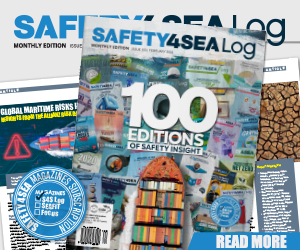The National Transportation Safety Board (NTSB) has released an investigation report on an incident where the bulk carrier American Mariner had begun transiting outbound in the Vidal Shoals Channel, near Sault Ste. Marie, Ontario, en route to Superior, Wisconsin, when the vessel grounded and sustained damage to three ballast water tanks.
The incident
On January 7, before dawn, the bulk carrier American Mariner grounded after departing the Algoma Sawmill Bay Dock near Sault Ste. Marie, Ontario, and maneuvering into the Vidal Shoals Channel. The ship proceeded to a shipyard in Superior, Wisconsin, arriving on January 10. Crewmembers reported a sound and “shudder” while the master was maneuvering the vessel into the Vidal Shoals Channel; they then discovered that one of the vessel’s ballast tanks appeared to be communicating with the lake, and therefore was likely damaged. Although the master stated the ship was in the channel, the shoals were located immediately outside the buoyed channel and the AIS data from that time showed the vessel on the far (southeast) side of the channel.
After the vessel was drydocked, damage to three ballast tanks at the bilge chine along the port side was found—including breaches of the hull to hold no. 6. Given the crew reports, damage to the port chine and bottom plating, and the vessel’s position at the southeast edge of the channel, the American Mariner grounded on Vidal Shoals at the edge of the channel.
When departing the Algoma Sawmill Bay Dock, the ship had to avoid shoal water south of the dock (marked by buoy QM14). The NTSB reviewed data for two
years of port calls at the dock. Four of the seven times American Mariner left the facility, including all three times after the grounding, the vessel moved astern about a ship’s length, where there was more room to maneuver, before coming ahead and entering the channel at a shallow angle and lining up on the centerline. On the casualty voyage, the master did not leave enough room between the ship and this shoal water, forcing a hard port turn once underway. The heading and position from that turn resulted in the ship entering the channel at a steep angle, which required a sharp turn to starboard to stay within the channel and avoid the shoals at the opposite side of the channel. Therefore, the master’s initial angle of departure from the dock and close approach to the shoal water by buoy QM14 positioned the vessel at a poor angle to successfully maneuver into the channel, which resulted in the vessel overshooting the turn and grounding on the shoals on the opposite side of the channel.
At the time of the grounding, it was dark and the seasonal channel buoys were unlit, which would have made it more difficult for the master to see the channel.
Rose Point ECS software, which the master was using to navigate, allows users to overlay the footprint of the vessel on the chart display. (Without this, the ship appears as a dot or small icon at the position of the GPS antenna or at an offset reference point.) According to the master, this vessel footprint overlay feature was not used. Additionally, the captain was alone on the bridge (there was no regulatory or company requirement for additional bridge watchstanders), having to multi-task the navigation, steering, and lookout duties as the vessel departed the dock and attempted to enter the channel. Without additional personnel on the bridge, the master had to split his concentration between these tasks, which, in conjunction with the darkness, unlit buoys, and not using the ECS footprint feature, likely compromised his ability to successfully navigate the vessel into the channel.
Conclusions
Probable Cause
The National Transportation Safety Board determines that the probable cause of the grounding of the bulk carrier American Mariner was the master maneuvering the vessel away from the dock and into the channel while alone on the bridge, which required him to multitask (navigation, steering, and lookout duties) and resulted in the vessel overshooting the turn into the channel and running aground on the shoals on the opposite side of the channel.
Lessons Learned
Determining Bridge Team Staffing
While maneuvering in confined waters, it is difficult for a single bridge crewmember to effectively drive, lookout, and monitor and use available bridge
equipment. The composition of a bridge team may vary based on the complexity of the maneuver or operation being carried out. Typically, maneuvers like docking or undocking, transiting in or out of port, or operating in areas of high traffic density require additional personnel to handle navigation-related duties. Owners, operators, and vessel masters are responsible for ensuring that bridge teams are staffed with a sufficient number of certified/credentialed mariners who are familiar with all bridge navigation equipment and able to independently take immediate action. Additionally, the effective use of all available resources by a bridge team, including visual scanning, radars, electronic charts, and an automatic identification system, increases collective situational awareness and contributes to a safe navigation watch.
































































Question after an incident: What in our system do we need to change/update?
No point in just blaming the master.